They came from distant Asian steppes, they carried death and destruction. They showed no fear or pity. They appeared suddenly and suddenly disappeared, pretending to retreat and dragging the opponent into a trap. In 1241, the Mongolian onslaught, led by the grandson of Genghis Khan himself, set off on the divided Polish state with great impetus. Tatars murdered and plundered. They put Krakow on fire. They found stronger resistance only on the western frontiers of Poland. Near Legnica, the Silesian prince, Henryk the Pious, stood against them. He was killed at the hands of the Tartars for defending the country against the onslaught of pagans. To this day, it is not clear whether he died in combat or was martyred by his enemies.
Tatar cruelty first manifested itself in the eastern parts of the country at the beginning of the tragic year of 1241. Then strange-looking warriors, with flat noses, small eyes, equipped with curved swords, spears with hooks, bows and quivers full of arrows appeared in the vicinity of Lublin.
The invasion showed the Poles what a wild enemy they will have to face. Suddenly, they appeared on their maneuvering horses. On the spot, they immediately murdered the elderly, children and the sick. They burned the city. To those they found worthy slaves, they put ropes around their necks. Then they chased them in the bitter frost and drove them with blows of nahae. Anyone who could not keep pace was killed.
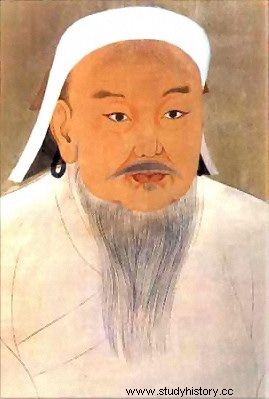
Genghis Khan was the founder of the Mongol Empire
Soon before, about 100,000 disciplined and resistant to hardships Mongolian soldiers bloodily subjugated Kiev Ruthenia. After this success, the Tatars (a common name - used as a synonym for the Mongols in Europe at that time. In fact, the Tatars were only one of the tribes included in the Mongol empire. It became popular, among others, due to the similarity to the Greek word Tartarus, i.e. the mythological hell) they were going to strike in two directions. The main Mongolian forces led by Batu Khan - the grandson of the great Genghis Khan were headed towards Hungary of King Bela IV, while a faction of Mongolian troops led by Baidar was to invade and plunder Poland while preventing Poles from supporting allied Hungarians.
In January 1241, Asian warriors, looking like messengers from hell, blew Lublin and Zawichost on fire. It was merely a reconnaissance, but enough to make the neighboring towns fearful. The commander was to remember the way, so that he would return soon with the entire army. It also happened.
Tatar Blitzkrieg
In February 1241, a Mongol invasion of more than 10,000 horsemen hit the interior of the country. Bands of Asian warriors approached Sandomierz, which at that time was bursting at the seams with refugees terrified by tales of Tatar cruelty, which they gave a sample in Lublin. Sandomierz defended himself bravely. During the fighting, the defenders even managed to kill one of the major Mongol commanders. He was such a significant figure that the invaders, throughout the campaign, carried his corpse with them to be buried in their homeland. Ultimately, however, on February 13, 1241, Sandomierz fell. After breaking into the city, the Tatars began a regular slaughter of the inhabitants.
This is how Jan Długosz described these events.
Having finally conquered them, they kill the abbot of Koprzywnica and all the brothers of the Kopřivnice monastery, the Cistercian order, and a large number of clergy and lay people, men and women, nobility and people of both sexes who gathered there in order to save lives or defend the place. They organize a great slaughter of old people and children, and spare only a few young people, but they chase them like the worst slaves in terrible stocks.
After the destruction of Sandomierz, the steppe riders stood for the first time in the open field against the Polish cavalry. The knights gathered under the command of Włodzimierz - the starost of Krakow. Both troops met in the area of the village of Tursko Wielkie. The Poles managed to gain an advantage in the initial phase of the battle. They forced the Tatars to flee, but did not realize that it was a sham maneuver.
After they chased the enemy from the battlefield, convinced that it was all over, they started looking for loot - collecting weapons from the battlefield, abandoned equipment, valuables, and even taking clothes off the corpses. All of this was suddenly launched by the Tatar cavalry, forcing the Poles to flee panically.
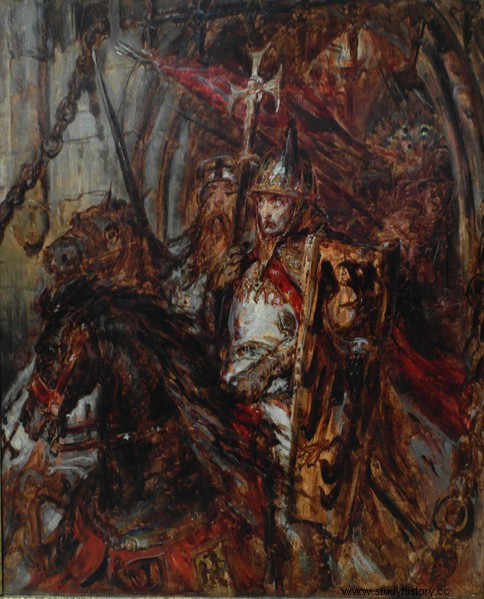
Henryk the Pious
Even so, the battle was not a complete defeat. The Mongols suffered such heavy losses that they decided to withdraw. First, they hid deep in the forest, then returned to Russia.
In March, the stronger came. A dozen or so thousand warriors led by Orda - the grandson of Genghis-Khan himself, went to Krakow. Another 10,000 to the north towards Kujawy, in order to return south after the slaughter and fires.
Just before the arrival of the Asians, Krakow almost completely depopulated, despite the fact that it was full of refugees earlier. The news of another defeat of the Polish knighthood - near Chmielnik - caused panic in the city. The then 15-year-old prince of the Sandomierz district - Bolesław the Chaste - escaped to Hungary. On the other hand, the people fled wherever possible, most often in woods, in the hope that the forests would be able to wait through the slaughter.
On April 1, 1241, the Tatars entered Krakow, which was almost abandoned. Only the Okół crew (the former Wawel suburbs) defended themselves and ultimately the Mongols did not break them, although it must be admitted that they did not care much about it. They burnt the buildings and moved on towards Silesia.
At that time, in Silesia, Prince Henry the Pious and foreign reinforcements were waiting for the Tatars. The battles in Małopolska - although lost by the Polish knights - slowed down the Mongol expansion so much that the Pious had managed to gather an army composed of the forces of district princes, Moravian reinforcements, crusaders (Templars, Knights and probably also knights of the German Order - Teutonic Knights) and German miners. The entire European is estimated at around 6,000 - 7,000 knights. In turn, the Mongols had about 8,000-10,000 people.
Such armies, originating from two different cultures and two different military models, faced each other probably in the area of today's Legnickie Pole, a few kilometers from Legnica.
Obese gives back
This time, the Poles were more vigilant and did not fall so easily into a mock retreat. On the contrary - it was the heavy armed troops led by the Pious who managed to surprise and break the Tatars. The enemy got caught by the bait himself. When most of the Mongolian troops were already in the field and fought with troops of monks and volunteers from abroad, the Polish heavy-armed knights fell on the enemy.
Lightly armed Tatars on small horses felt the knights' roller, supported by a cannonade of crossbows. The Mongols began to retreat. It seemed that they would ultimately fail, but then something happened that led to the defeat of the Europeans.
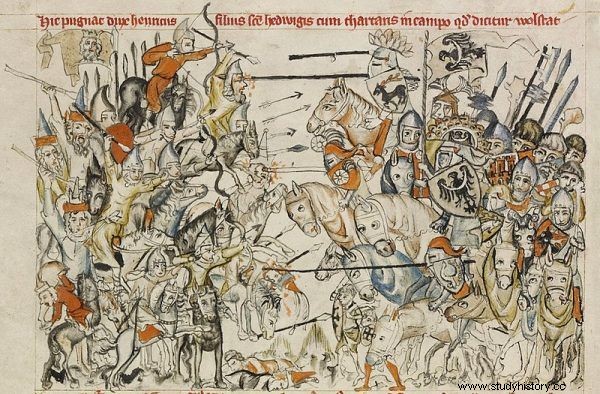
The Battle of Legnica, The Legend of Saint Jadwiga (1353)
Suddenly, for some unexplained reason, there was a signal to retreat among Poles!
The case is described by Jan Długosz in his Chronicle who mentions that at some point a rider appeared in front of the knights shouting: Run! Keep going! In fact, Długosz wrote these words in Polish as the only ones in this account. Who was this rider? Did he really call for flight, or was he misunderstood? Perhaps it was a ruse of the Mongols? Or maybe it was one of the Russian soldiers, forced to fight in the Tatar ranks, shouting these words?
Today it's hard to say what really happened, but the troops of the Duke of Opole, Mieszko II the Obese, interpreted these words as a signal to escape and began to withdraw. Henry the Pious tried to prevent this and with his army he went deep into the enemy forces, but this did not stop the confusion among the Poles.
Medieval Chemical Weapons
Later something happened that some historians interpret as the use of war gases by the Mongols. Such a statement may seem sensational. Chemical weapons did not make their debut on the battlefield in the 20th century, during World War I (used by the Germans in the Battle of Ypres in 1915). 700 years earlier, the steppe invaders knew similar solutions that they had borrowed from the Chinese.
As Jan Długosz recalls:
She was there in their (Mongolian) army, among other banners one huge size. (...) on the top of its pole was the figure of a very ugly and monstrous head with a beard, so when the Tatars stepped back one step back and were taking to flee, the ensign carrying the banner started to wave this head with all his might, and it immediately burst out of it some dense steam, smoke and a gust so foul that after the spread of this killer smell among the troops, the Poles, faint and barely alive, would stand still and were unable to fight.
Were chemical weapons used on Polish knights? It is not known, at least the ranks of the Poles disintegrated.
Prince without a head
Surrounded by enemies, Prince Henry, accompanied by a few knights from the nearest entourage, defended himself bravely and fiercely, but the pressure of the Asians intensified. It was not possible to break the prince from his death grip. Henry the Pious did not survive the clash with the Mongol invaders. To this day, however, it is not entirely clear exactly how he died.
According to Jan Długosz, he died on the battlefield:
But when, raising his right hand, he was about to hit the Tatar who blocked his way, the other Tatar pierced his arm with a spear. [The prince], hanging his arm, slipped off his horse, stabbed to death. The Tatars, amid loud shouts and chaotic, unbelievable uproar, catch him and, having dragged him out of the fighting area within a distance of two litters with a crossbow, they cut off his head with a sword, tearing off badges, leaving his body naked.
It follows from this description that the decapitation of Henry the Pious's head took place after his death. It was therefore a profanation of a corpse.
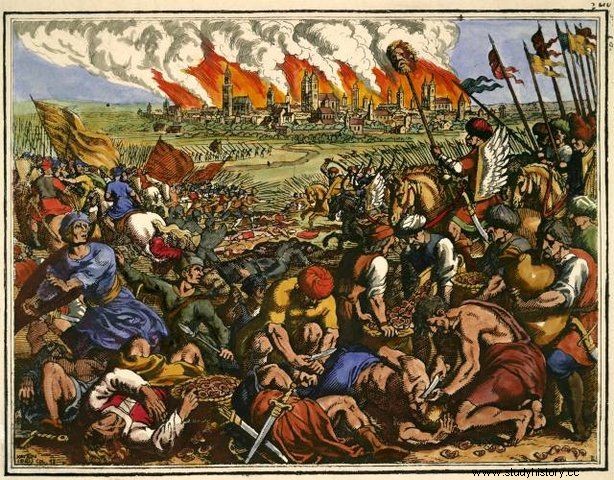
Battle of Legnica
However, we get a different account from the Franciscan Benedict, a Pole, who in 1245 set off with the papal mission to the Mongol Khan - Ujuka, grandson of Genghis-Khan. The Franciscan account of this journey was written by his companion - a certain de Brida, also a monk. This is how Historia Tartarorum was created , that is, the History of the Tatars.
This chronicle work contains another account of the death of the Pious. It shows that the prince was captured and martyred.
Then the Tatars captured Prince Henry. Having robbed him completely, they ordered him to kneel for execution in front of the body of the prince previously killed in Sandomierz. They delivered his head through Moravia to Batu Khan and threw it in front of the other severed heads.
These "corpse of the prince" would probably be the body of a more significant Tatar commander who died during the siege of Sandomierz.
The desecrated body of Henry the Pious was recognized on the battlefield by his wife. She identified the husband by an anatomical anomaly, namely the six toes, which the ruler was said to have had. Did he really have one finger more? We will not find out because the prince's body, which was originally located in the church of St. st. Wincentego and Jakub in Wrocław… lost! They were lost during the war. From Wrocław, the Germans took them deep into the Third Reich and there they disappeared without a trace.
Epilogue
And the warriors from hell? After the prince's head was cut off, they were supposed to ride with it on a spear around the Legnica castle, trying to force the crew to surrender. Ultimately, however, they let go of the siege. They destroyed several surrounding villages and headed south as planned to join Batu Khan's main forces and conquer Hungary as planned. Along the way, they destroyed Moravia, and after breaking through the Hungarians, they harassed the Balkans with invasions. The gateway to the West was open to them, but they eventually withdrew.
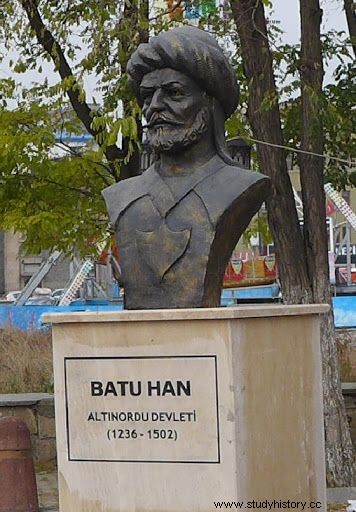
Batu Khan, the Mongol ruler, grandson of Genghis Khan
In the 13th century, the Mongols invaded Poland twice more. While the second time - at the turn of 1259/1260 - the Tatar invasion again moved around the country without any obstacles, the third invasion at the turn of 1287 and 1288 ended with the defeat of the Tatars. They were displaced, among others from Podhale, where the highlanders resisted them. The cities also defended themselves bravely. The Tatars have not managed to get hold of any of the large centers. Seeing the determination and cooperation of the Poles with Hungarian reinforcements, the steppe warriors retreated to Halicka Ruthenia (the region of today's northwestern Ukraine), which they plundered by vetoing the unsuccessful invasion of Poland.
Unfortunately, it was not the end of the bloody struggle with the hellish fields. From the end of the 15th century, the Tatars from the Crimean Khanate regularly invaded the Commonwealth for two more centuries, plundering, murdering and burning the eastern borders of the country. Their invasions resulted in the complete depopulation of some areas in the borderlands. It is estimated that hundreds of thousands of people hit the Tatar Jasyr.
Historical sources:
de Bridia C., Historia Tatars [in:] A meeting of two worlds. The Holy See and the Mongolian world in the mid-thirteenth century. Relationships established in connection with Jan di Piano Carpini's mission to the Mongols, edited by Jerzy Strzelczyk, Poznań 1993
